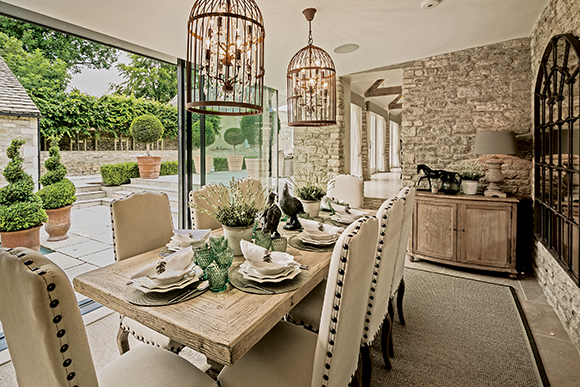Award-winning designers offer advice on creating beautiful garden rooms, orangeries and beachside cabanas that blur the boundaries between indoor and outdoor areas.
here’s little doubt that getting back to nature brings with it a definite sense of well-being. So, if you can bring a feeling of being outdoors inside with lots of sunlight and natural finishes and textures throughout the space, all the better.
Alexander James Interiors’ goal is to help each client maximise the full potential of their home, introducing bespoke designs which are tailored to their individual requirements. The company designed the garden dining room featured here which is full of traditional Cotswolds’ charm. It has a relaxed country style scheme with lots of patterns and textures for a tranquil and homely interior.
Stacey Sibley, the company’s creative director, explains, “The glass link uniting the barn with the main house creates a stunning, light dining room with a full-length wall of windows looking out across the central courtyard. This formed a seamless transition, bringing the beautiful garden indoors, an important feature of garden room design.
“We adopted an organic, earthy scheme, with a traditional Cotswold stone wall acting as the perfect backdrop to the design. Copper tones were used in this room as the tone of the metal sits beautifully with the exposed, tumbled brick walls and is echoed in the large, studded edging on the off-white linen chairs and also in the bird cage ceiling lights and tear drop wall lights. The oversized arch framed mirrors are used along the back stone wall to imitate a row of windows, effectively reflecting the garden back into the dining room.
“The aviary lighting pieces are a strong influence in this design, acting as the basis of the nature inspired avian theme. The lighting reflects beautiful patterns on the ceiling, adding further depth and detail to the design. A theme of nature is an effective way of perfectly integrating a garden room with the outdoors.
“We used a chunky wooden table in lime washed Oakwood, with a detailed criss-cross top and carved base, placed upon a thick hessian rug with a rich olive and lime bordered edge. The rustic, wooden sideboard in the corner sits against the stone wall, creating a contrast of textures within the neutral palette of colours. We recommend earthy materials in garden rooms for an organic fee and added gentle accents of green in our dining table design to reinforce the botanical nature of the scheme.”
Natural and light
Milc Property Stylists is renowned for bring eye-catching and innovative interiors to the UK property market. The company’s senior interior designer, Sylwia Lubian, advises that, when thinking about design for indoor garden rooms or orangeries, first think carefully about the purpose of such spaces and their origins and what they really mean to you.
“They are simply extensions of our garden or become reminiscent of one if we live in a super urban environment,” she says. “I always recommend using natural and light textures and finishes to make such interior space as airy and close to nature as possible. You can use soft linens and cotton blend fabrics for upholstered furniture and soft, comfortable wools and cashmere for a touch of luxury and sophistication through the use of soft furnishing. Try to keep the internal furniture layout as open and spacious as possible to allow freedom of movement.
“Indoor garden spaces should take advantage of allowing nature inside and enable real plants to become a primary focal point. Following the 2018 trend of ‘maximalism’, I would suggest going bigger and bolder when choosing your greenery. Drop the idea of accessorising your garden room with miniscule potted orchids or succulents and bravely reach out for larger potted olive trees, ferns or citruses which are my all-time favourites. Think about them as you would about an expensive piece of furniture which you would expose proudly in the centre of the room.”
“A theme of nature is an effective way of perfectly integrating a garden room with the outdoors”
Caribbean cabana
Wilkinson Beven, a company specialising in designing beautiful residential interiors in the UK and around the world, was asked to design a Caribbean beachside cabana. Working alongside the project architect, the client’s brief was for the cabana to be in-keeping with the property’s style, allowing its location by the sea to be enjoyed to its full.
John Beven, director of Wilkinson Beven, explains, “Its aim was to provide intimacy and shelter during the day and an escape from the main house in the evening. Specifying light, ‘beachy’ fabrics suitable for the location allowed conventional interior furniture to be used in an exposed setting. This enables a higher level of comfort to be achieved, while driftwood coffee tables provide a sense of being on the beach.
‘Louvered shutters provide an intimacy retaining a circulation of air important for Caribbean living, allowing the main view to be seaward and the cabana to be a place of escape from the rest of the property’s landscape. Glass balustrades to the front retain the views but also give shelter when seated. Quality external fabrics allow the comfort level of interior furniture to be used in a challenging open environment, making the space feel more interior linked to a luxury interior than an external garden space.”


